目录
1.2、getSpringFactoriesInstances(Class type)
2、SpringApplication的run(String… args)启动函数运行过程分解
使用SpringApplication类用来启动Spring时,默认会执行以下主要步骤来启动应用:
- 根据classpath创建一个相应的ApplicationContext
- 注册一个CommandLinePropertySource来曝光命令行参数作为spring的属性
- 刷新application context来加载所有的单例bean
- 触发CommandLineRunner的bean实例的run方法
//启动SpringBootApplication
@SpringBootApplication
public class MvcApplication {
public static void main(String[] args) {
SpringApplication.run(MvcApplication.class, args);
}
}SpringBoot的启动流程分析:
1、SpringApplication构造函数
运行SpringApplication.run(MvcApplication.class, args)方法时,SpringApplication类首先会创建一个SpringApplication对象实例,然后再执行其相应的run方法
我们先看SpringApplication的构造函数:

该构造函数主要是为一些变量属性赋值:
- primarySources属性,即SpringApplication.run(MvcApplication.class, args) 中传入的MvcApplication.class,该类为SpringBoot项目的启动类,主要从该类的configuration类加载bean
- webApplicationType属性,代表应用类型,根据classpath存在的相应Application类来判断,
见1.1 deduceFromClasspath()方法
- initializers属性,ApplicationContextInitializer 数组,从spring.factories配置文件中加载,
见1.2 getSpringFactoriesInstances(Class type)方法。
- listeners属性,ApplicationListener 数组,从spring.factories配置文件中加载
- mainApplicationClass属性,获得哪个类调用了main(String[] args) 方法的信息,比如mainApplicationClass这里是“class com.sinkfish.generatemybatis.GenerateMyBatisApplication”启动了main方法,仅仅用来打印日志
1.1、deduceFromClasspath()
此类将根据classpath判断应用类型
通过反射加载classpath判断指定的标志类存在与否来分别判断是reactive应用,web应用还是非web应用

1.2、getSpringFactoriesInstances(Class type)

先根据接口类从项目的所有spring.factories配置文件中获得相应的具体实现类放入names集合,然后再调用createSpringFactoriesInstances方法创建具体的实例,下面是createSpringFactoriesInstances方法:
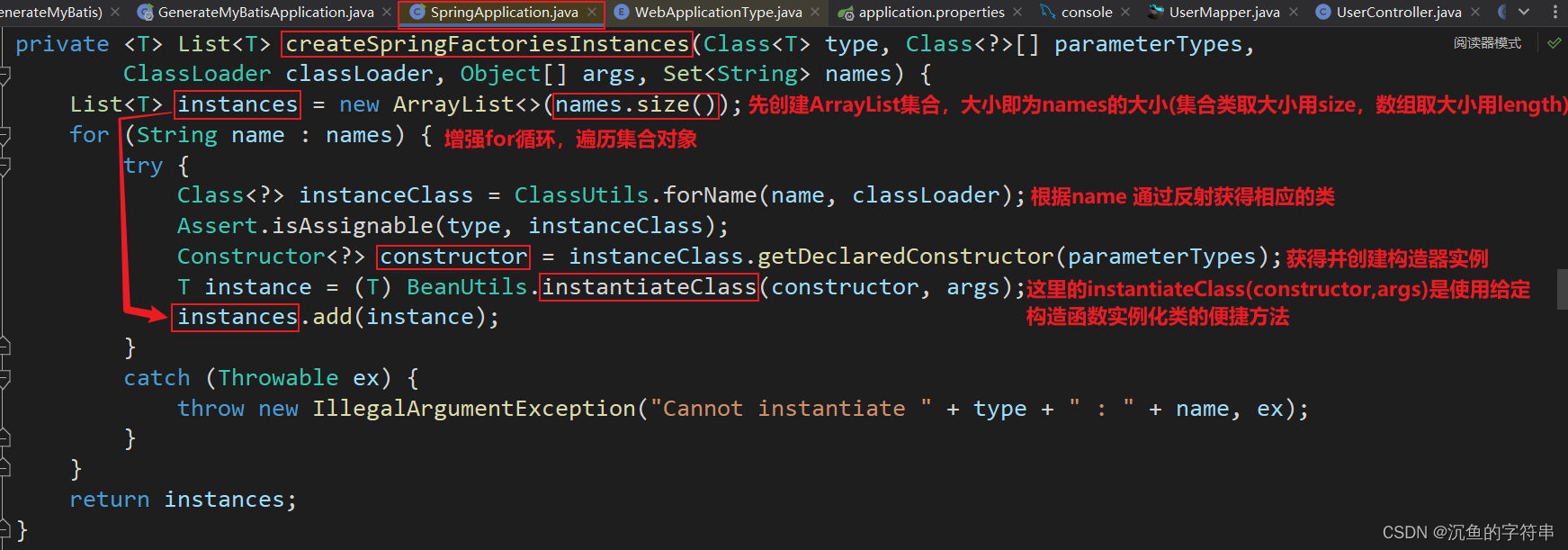
根据传入的接口类型从spring.factories配置文件中加载相应的实例,
比如:getSpringFactoriesInstances(ApplicationContextInitializer.class)方法根据ApplicationContextInitializer.class接口类去spring.factories配置文件寻找具体实现类,最终初始化到初始化 initializers 属性中,给initializers属性打上断点

经过调试,ApplicationContextInitializer接口具体实现类有:
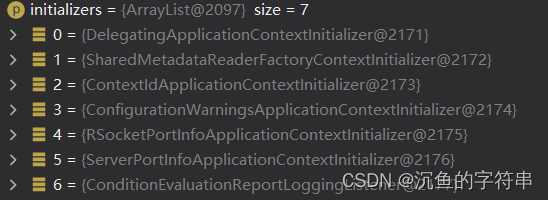
同理ApplicationListener的具体实现类如下:
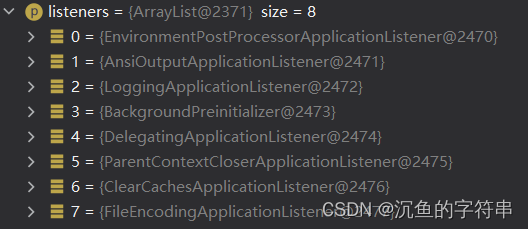
2、SpringApplication的run(String… args)启动函数运行过程分解
前面分析了SpringApplication的构造函数,下面来分析该类的run方法。
在SpringApplication类中按下
alt + 7,查看该类的结构图
查看三个方法:

用上面相同的方法找到重载的run构造方法
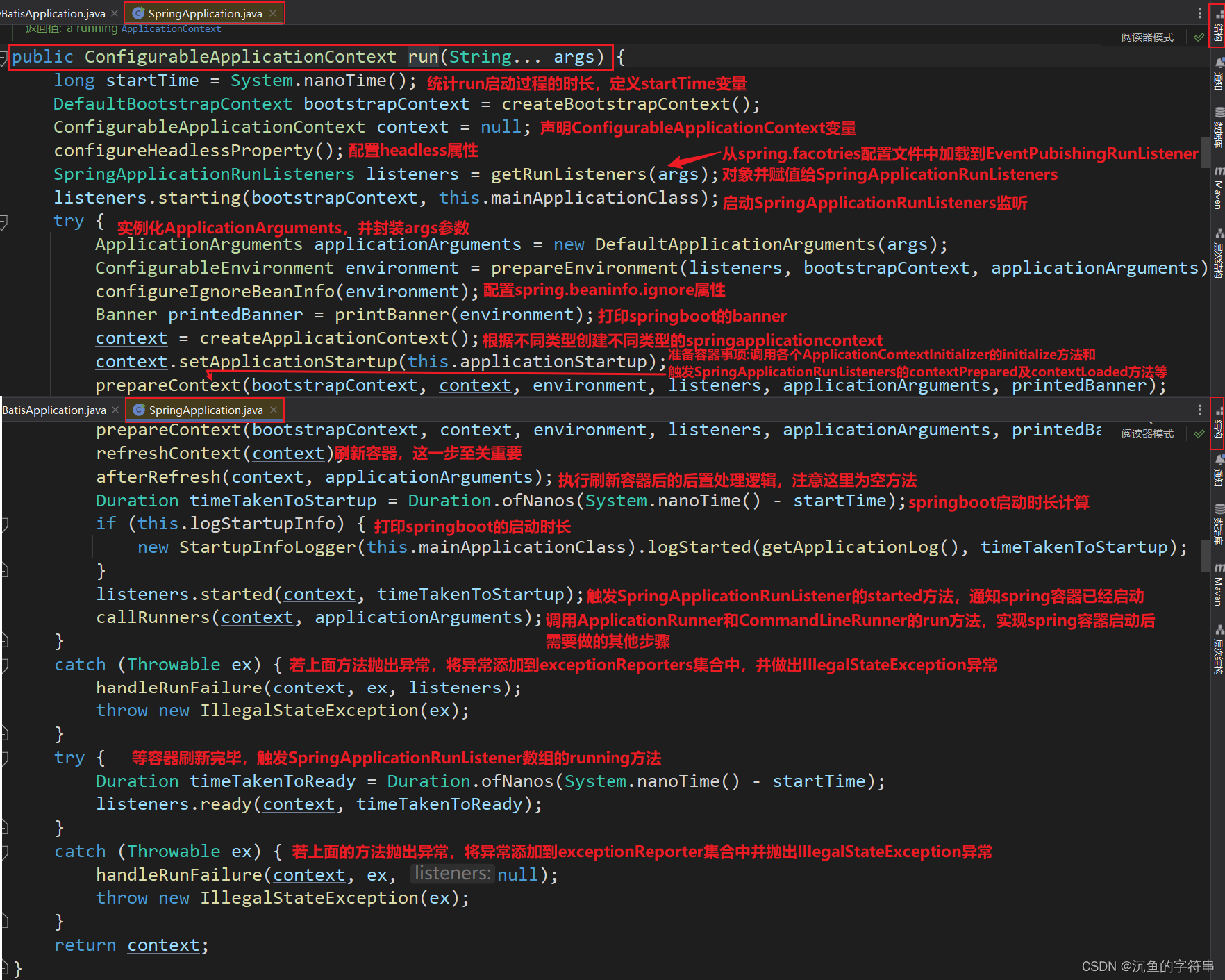
总结如下:
1,实例化startTime变量用于统计run启动过程时长
2,调用configureHeadlessProperty()方法配置headless
即“java.awt.headless”属性,默认为ture,那么做了这样的操作后,SpringBoot想干什么呢?
其实是想设置该应用程序,即使没有检测到显示器,也允许其启动.对于服务器来说,是不需要显示器的,所以要这样设置.
参考:www.cnblogs.com/wangxuejian…
3,获取SpringApplicationRunListeners,并启动SpringApplicationRunListener的监听,此时利用EventPublishingRunListener的initialMulticaster对象来发布ApplicationStartingEvent事件,表示SpringApplication开始启动,监听ApplicationStartingEvent事件的listeners们将会执行相应逻辑。
注意:EventPublishingRunListener拥有SpringApplication属性。
4,调用prepareEnvironment方法准备environment,比如准备配置参数有servlet配置参数,外部配置参数比如jvm启动参数等。详情请见2.1 prepareEnvironment方法
5,调用printBanner(environment)方法打印springboot的bannner
6,调用createApplicationContext()方法根据webApplicationType创建容器context,因为是web项目,这里创建的是AnnotationConfigServletWebServerApplicationContext容器对象,详情请见2.2 createApplicationContext方法
7,调用prepareContext方法准备容器事项,比如调用调用各个ApplicationContextInitializer的initialize初始化方法
和触发SpringApplicationRunListeners的contextPrepared及contextLoaded方法等,详情请见2.3 prepareContext方法
8,调用refreshContext方法最终调用AbstractApplicatioinContetext.refresh()方法刷新容器,这一步至关重要,因为很多spring重要的逻辑都在这里处理,请见2.4 refreshContext方法
9,调用afterRefresh方法执行刷新容器后的后置处理逻辑,注意目前这里为空方法,留给子类去实现。
10,触发SpringApplicationRunListener的started方法,发布ApplicationStartedEvent事件,通知spring容器已经启动,相应listener监听该事件执行相应处理逻辑。
11,调用callRunners方法,即会调用ApplicationRunner和CommandLineRunner的run方法,实现spring容器启动后需要做的一些东西,详情请见2.5 callRunners方法
2.1、prepareEnvironment

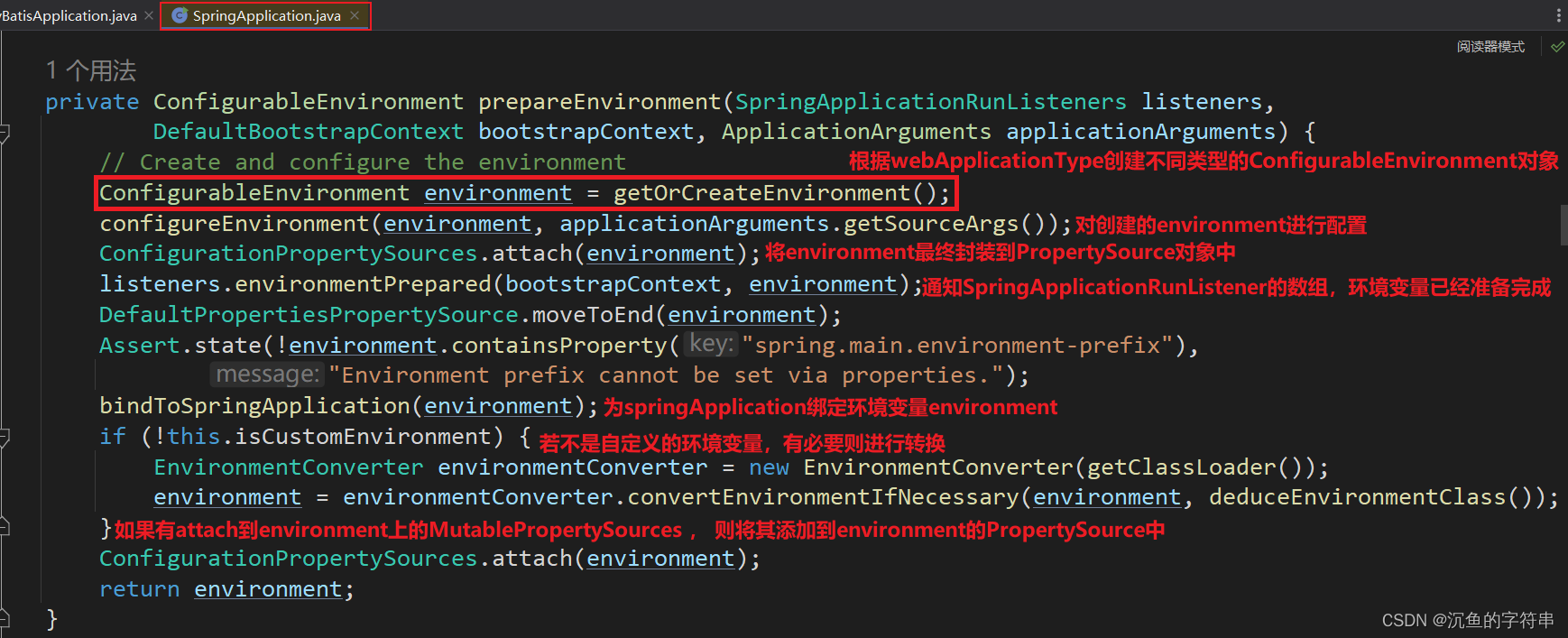
上面代码首先根据webApplicationType创建不同的environment对象,这里创建的是StandardServletEnvironment对象;然后对environment对象进行配置,比如增加 environment 的 PropertySource 属性源,还有配置哪个profile为actived;environment环境变量准备好后,此时发布ApplicationEnvironmentPreparedEvent事件,执行environment准备好后的相关逻辑;然后再将environment绑定到SpringApplication,对非自定义的environment进行转换等。
2.2、createApplicationContext

//该方法简化后的结构如下
protected ConfigurableApplicationContext createApplicationContext() {
Class<?> contextClass = this.applicationContextClass;
if (contextClass == null) {
try {
switch (this.webApplicationType) {
case SERVLET:
contextClass = Class.forName(DEFAULT_SERVLET_WEB_CONTEXT_CLASS);
break;
case REACTIVE:
contextClass = Class.forName(DEFAULT_REACTIVE_WEB_CONTEXT_CLASS);
break;
default:
contextClass = Class.forName(DEFAULT_CONTEXT_CLASS);
}
}
catch (ClassNotFoundException ex) {
throw new IllegalStateException(
"Unable create a default ApplicationContext, " + "please specify an
ApplicationContextClass",ex);
}
}
return (ConfigurableApplicationContext) BeanUtils.instantiateClass(contextClass);
}2.3、prepareContext
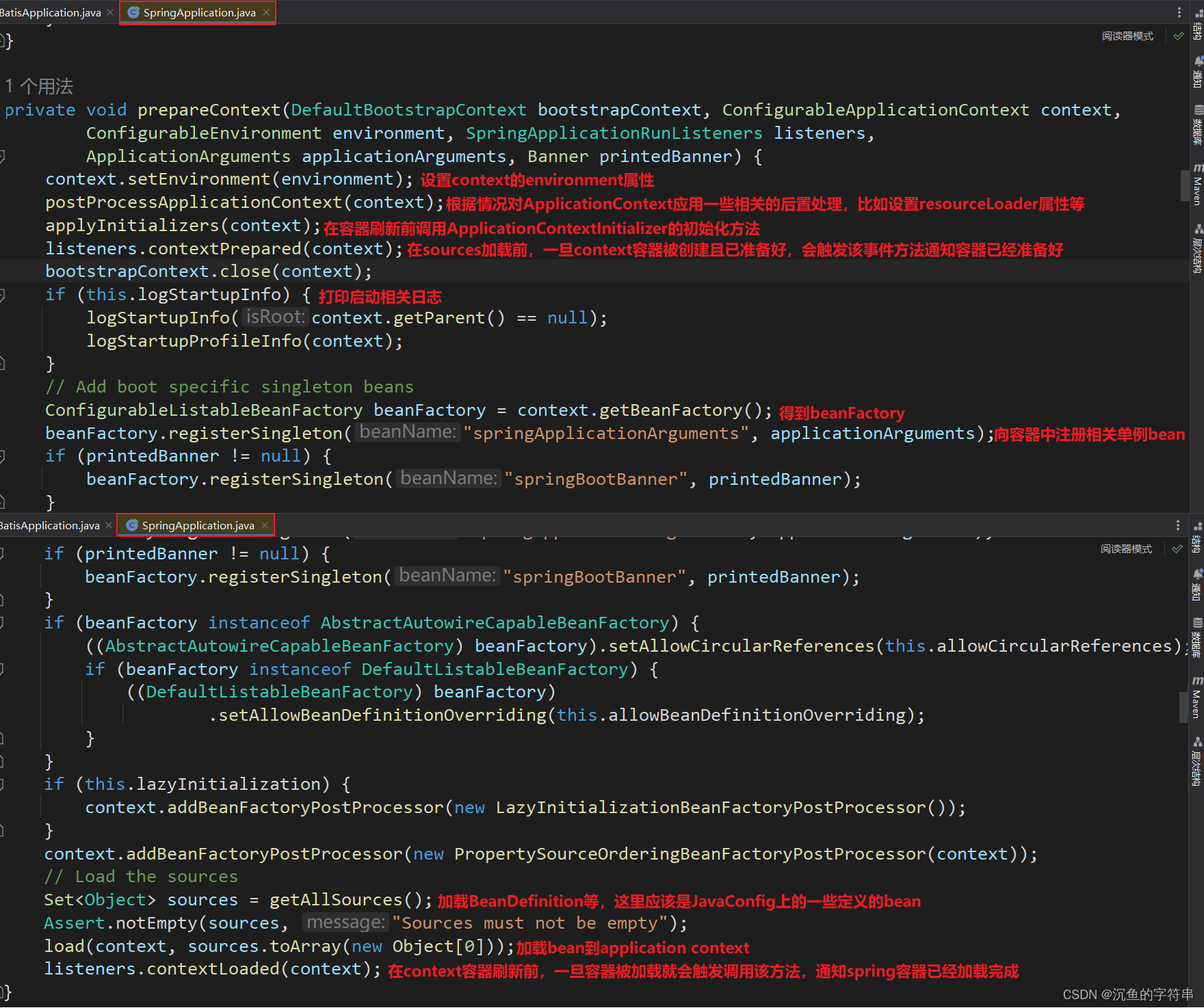
prepareContext主要是准备context,主要做了以下事情:
- postProcessApplicationContext(context),子类可以覆盖该方法做一些定制处理
- applyInitializers(context):这个是将之前从spring.factories中加载的ApplicationContextInitializer接口的具体实现类逐个应用其initialize初始化方法,执行一些初始化逻辑
- listeners.contextPrepared(context):发布ApplicationContextInitializedEvent事件,说明context已经准备好
- getAllSources():将primarySource加载出来,应该是之后要对其配置的javaconfig或xml配置的bean进行加载,这里留个疑问先。
- load(context, sources.toArray(new Object[0])):加载所有的配置文件比如javaconfig和xml配置文件的bean定义,这里创建了一个BeanDefinitionLoader对象;BeanDefinitionLoader作为AnnotatedBeanDefinitionReader,XmlBeanDefinitionReader和ClassPathBeanDefinitionScanner的门面,从底层源加载bean定义
- listeners.contextLoaded(context):发布ApplicationPreparedEvent,说明context已经加载完毕。
2.4、refreshContext
private void refreshContext(ConfigurableApplicationContext context) {
// 刷新容器
refresh(context);
// 若注册了shutdownHook钩子,则注册shutdownHook钩子
// JVM shutdownHook的作用是当jvm关闭时,关闭context容器,销毁相关bean
if (this.registerShutdownHook) {
try {
context.registerShutdownHook();
}
catch (AccessControlException ex) {
// Not allowed in some environments.
}
}
}
protected void refresh(ApplicationContext applicationContext) {
// 断言:applicationContext必须是AbstractApplicationContext的子类,否则报错
Assert.isInstanceOf(AbstractApplicationContext.class, applicationContext);
// 刷新容器
((AbstractApplicationContext) applicationContext).refresh();
}
public void refresh() throws BeansException, IllegalStateException {
synchronized (this.startupShutdownMonitor) {
// Prepare this context for refreshing.
// 在context刷新前做一些准备工作,比如设置context的启动日期,active flag和property sources的初始化工作
prepareRefresh();
// Tell the subclass to refresh the internal bean factory.
// 让子类刷新其内部bean factory,实质就是再新建一个DefaultListableBeanFactory类型的bean factory对象
// 加载xml配置的bean定义,注意加载annotation的bean定义应该是在invokeBeanFactoryPostProcessors方法中加载??
ConfigurableListableBeanFactory beanFactory = obtainFreshBeanFactory();
// Prepare the bean factory for use in this context.
// 上面那一步工厂刚建好,什么都没有,因此需要准备一些配置,
// 比如配置factory的标准容器特性,比如容器的类加载器和一些后置处理器比如ApplicationContextAwareProcessor 等
prepareBeanFactory(beanFactory);
try {
// Allows post-processing of the bean factory in context subclasses.
// 在经过上面的标准初始化后,修改应用容器的内部bean factory。
// 在这一步,所有的bean definitions将会被加载,但此时bean还不会被实例化
// 此时会注册一些BeanPostProcessors
postProcessBeanFactory(beanFactory);
// Invoke factory processors registered as beans in the context.
// Bean工厂的后置处理器的相关逻辑,BeanFactoryPostProcessor(触发时机:bean定义注册之后bean实例化之前)
// 和BeanDefinitionRegistryPostProcessor(触发时机:bean定义注册之前),所以可以在Bean工厂的后置处理器中修改Bean的定义信息,
// 比如是否延迟加载、加入一些新的Bean的定义信息等实例化所有注册的BeanFactoryPostProcessor beans,并且调用其后置处理方法
// BeanFactoryPostProcessor 是针对 BeanFactory 的扩展,主要用在 bean 实例化之前,读取 bean 的定义,并可以修改它。
invokeBeanFactoryPostProcessors(beanFactory);
// Register bean processors that intercept bean creation.
// 实例化并注册所有Bean的后置处理器:BeanPostProcessor beans,册所有的 BeanPostProcessor,将所有实现了 BeanPostProcessor 接口的类加载到 BeanFactory 中。
// registerBeanPostProcessors 方法主要用于处理 BeanPostProcessor 接口,调用时机:必须在所有bean的实例化之前调用
// BeanPostProcessor 是针对 bean 的扩展,主要用在 bean 实例化之后,执行初始化方法前后,允许开发者对 bean 实例进行修改。
registerBeanPostProcessors(beanFactory);
// Initialize message source for this context.
// 这里的逻辑主要跟国际化有关
initMessageSource();
// Initialize event multicaster for this context.
// 初始化事件广播器,如果自定义了广播器,就用自定义的,
// 如果没有自定义就用默认得SimpleApplicationEventMulticaster广播器。并且把广播器设置到上下文的applicationEventMulticaster属性中。
initApplicationEventMulticaster();
// Initialize other special beans in specific context subclasses.
// 这个是个模板方法,留给子类实现,在特殊的bean初始化之前和单例bean实例化之前调用
// 这里应该可以扩展ThemeSource接口
onRefresh();
// Check for listener beans and register them.
// 注册实现了ApplicationListener接口的监听器,这里不会影响其他监听器的使用
registerListeners();
// Instantiate all remaining (non-lazy-init) singletons.
// 完成容器bean factory的初始化,并初始化所有剩余的单例bean
// 这个方法在容器刷新过程中非常重要,因为所有的bean,如果不是lazy-init的都会在这一步进行实例化,并且做一些处理。
finishBeanFactoryInitialization(beanFactory);
// Last step: publish corresponding event.
// 完成容器的刷新共工作,并且调用生命周期处理器的onRefresh()方法,并且发布ContextRefreshedEvent事件
finishRefresh();
}
catch (BeansException ex) {
if (logger.isWarnEnabled()) {
logger.warn("Exception encountered during context initialization - " +
"cancelling refresh attempt: " + ex);
}
// Destroy already created singletons to avoid dangling resources.
destroyBeans();
// Reset 'active' flag.
cancelRefresh(ex);
// Propagate exception to caller.
throw ex;
}
finally {
// Reset common introspection caches in Spring's core, since we
// might not ever need metadata for singleton beans anymore...
resetCommonCaches();
}
}
}refresh方法是spring容器的重头戏,很多重要复杂的逻辑都在这里实现。
比如所有beanFactory的创建,所有bean定义的加载,实例化,注册一些事件监听器比如实现了ApplicationListener接口的监听器,还有一些后置处理方法也在这里处理,下面主要讲下后置处理方法,beanFactoryPostProcessor和beanPostProcessor等后置处理器也在这里实现调用相应的后置处理方法,比如beanFactoryPostProcessor是bean工厂的bean属性处理容器,说通俗一些就是可以管理我们的bean工厂内所有的beandefinition(未实例化)数据,可以随心所欲的修改属性;BeanPostProcessor是Spring IOC容器给我们提供的一个扩展接口,通过该接口的postProcessBeforeInitialization和postProcessAfterInitialization方法可以在bean的初始化前后执行一些自定义的逻辑。
2.5、callRunners
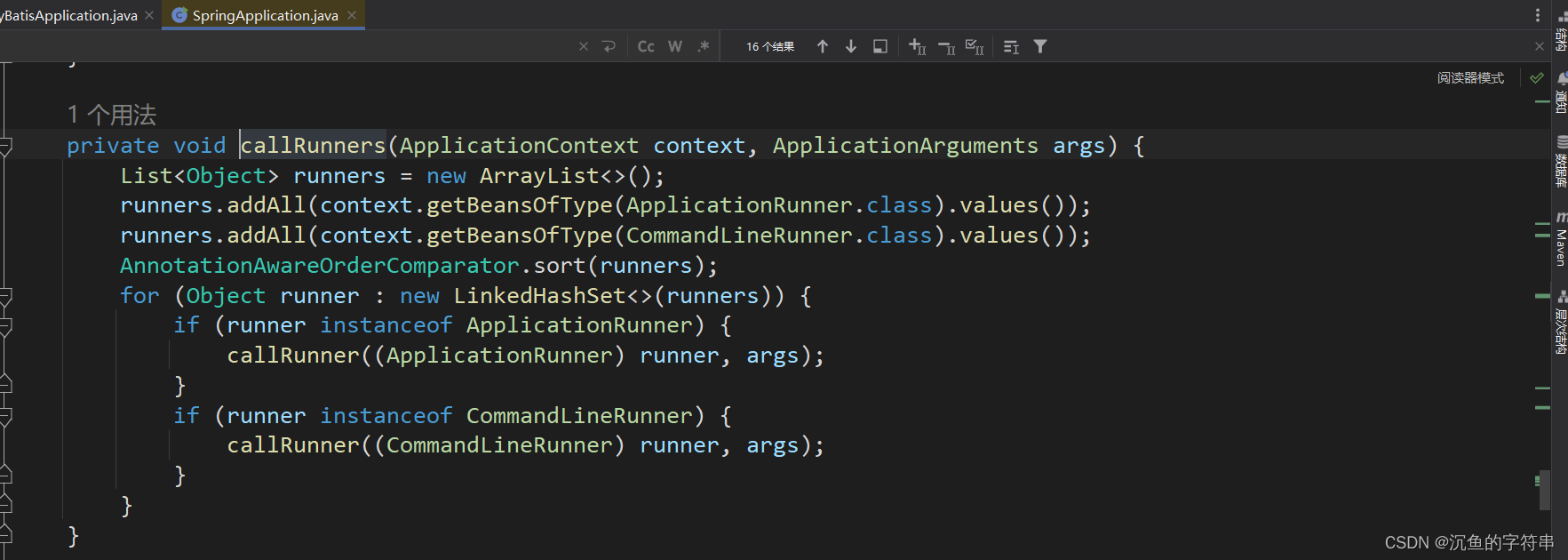
























 2490
2490











 被折叠的 条评论
为什么被折叠?
被折叠的 条评论
为什么被折叠?










